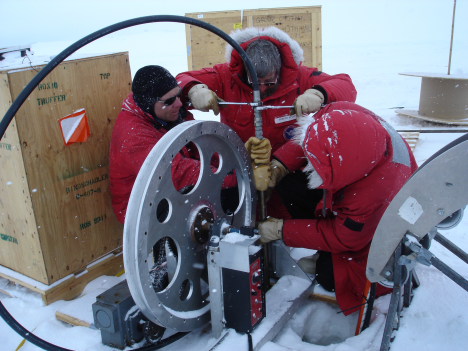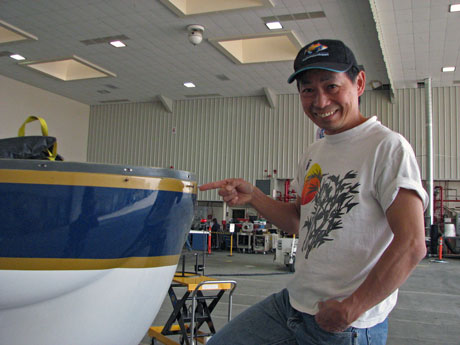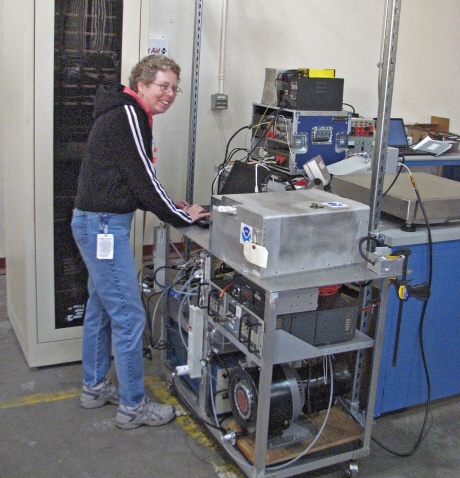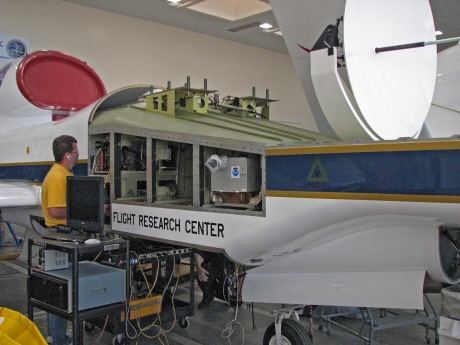

Dr. Robert Bindschadler reports on progress from his team’s work this past Antarctic summer. The project took a major step forward in 2010, although the work that was accomplished was completed far from the Pine Island area. The goal was to conduct field work together for the first time, try out as many techniques as possible and test as much equipment as we could. Looking forward to a return to Pine Island ice shelf in 2011-12.
Read more on the Pine Island Glacier site.

From Paul Newman, GloPac co-project scientist:
One of the instruments being flown on the Global Hawk is the Airborne Compact Atmospheric Mapper. ACAM is about the size of a microwave oven, and it is mounted in the bottom of the tail of the Global Hawk.
ACAM has two parts: a spectrometer and a high-definition video camera. We all know about cameras, but what is a spectrometer? It is used to measure light at hundreds of wavelengths (both visible and invisible). Sunlight is composed of many colors that combine to form white light, and each of these colors has a specific wavelength. For example, red has a wavelength of about 650 nanometers (or 650 billionths of a meter), green is about 510 nanometers, and blue is about 475 nanometers. Digital camera images combine the red, green, and blue wavelengths to create photos.
The ACAM spectrometer can see wavelengths from about 300 to 900
nanometers, and can resolve light differences of about 1 nanometer. So what good is that? Well, certain gases absorb certain wavelengths of light, but not others. For example, ozone absorbs very strongly 310 nanometers, but much less at 330 nanometers. This difference allows us to measure how much ozone is below the Global Hawk as we fly along. Hence, we use ACAM to measure things such as pollution and dust in the lower atmosphere.
I also mentioned that ACAM has an HD video camera. The ACAM principal investigator, Scott Janz, pulled the instrument out of the plane’s tail, turned it on its side, and pointed the instrument at the Global Hawk on Thursday morning. He added a little music to show all of the detailed work that is involved in our instrument integration. Of course, he also added me doing a bit of a dance in the video. As you can tell, the coffee on Thursday was over-caffeinated.
[youtube FDWeHmXPrNk 468]
From Paul Newman, co-project scientist for GloPac:
We’re making tremendous progress on installation of the instruments onto the Global Hawk, and we’re almost done cleaning up the myriad of issues.
During the integration this week, we’ve had to cut holes into the aircraft. I told Chris Naftel, the Global Hawk program manager, that we had to cut some holes into the plane for the Meteorological Measurement System (MMS). Chris replied: “I don’t want to hear anything about the holes. It pains me!” In spite of Chris’ pain, the little MMS holes are critical for measuring winds.
You’re now asking, what? Little holes? For winds? What kind of smoke and mirrors is that measurement? It’s actually a very slick little measurement that relies on the work of Daniel Bernoulli, a Dutch mathematician who lived in the 1700s. Bernoulli recognized that a wind difference between two holes would create a pressure difference. If you measure the pressure difference, than you’re measuring the wind difference. You can use a global positioning system card (just like the one in your car’s GPS) to measure the speed and direction of the plane. The difference between the speed of the air flowing over the nose of the plane and the plane’s ground speed will tell you the wind speed. Thank you Dr. Bernoulli!

Thaopaul (Paul) Bui of NASA’s Ames Research Center has designed the MMS to measure these small wind differences using the little holes drilled around the nose of the Global Hawk. The picture shows Paul pointing to one of his little holes. There are a total of five to allow him to get the North-South, East-West, and up-down winds.
Sorry Chris, but no pain, no “science” gain.

NASA’s Operation IceBridge mission, the largest airborne survey ever flown of Earth’s polar ice, kicks off its second year of study when NASA aircraft arrive in Greenland March 22.
The IceBridge mission allows scientists to track changes in the extent and thickness of polar ice, which is important for understanding ice dynamics. IceBridge began in March 2009 as a means to fill the gap in polar observations between the loss of NASA’s Ice, Cloud and land Elevation Satellite, or ICESat, and the launch of ICESat-2, planned for 2015. Annual missions fly over the Arctic in March and April and over Antarctica in October and November.
Follow their progress over the next several weeks on the Operation IceBridge blog.
From Paul Newman, mission co-project scientist:
We have had some success in bolting our instruments onto the Global Hawk. We just completed installing the NOAA ozone instrument, led by Laurel Watts, one of several National Oceanic and Atmospheric Administration scientists participating in the campaign. (The principle investigator for the instrument is Ru-Shan Gao, but Laurel has been handling the instrument for the past week.)
NOAA is playing a big role in the GloPac mission. My co-project scientist is Dr. David Fahey of NOAA; he was recently featured in The Washington Post. One of our pilots is Commander Phil Hall of the NOAA Corps.
Ozone is a crucial gas in our atmosphere because it absorbs harmful solar ultraviolet radiation. Excessive UV can lead to skin cancer and other health problems. Ozone is also a greenhouse gas, and ozone depletion in the stratosphere actually cools the Earth’s surface.
The ozone instrument works by taking a stream of air from outside the plane and passing it into the body of the instrument. The air flows between a lamp that emits ultraviolet radiation and a UV detector. Because ozone strongly absorbs UV, if there is more ozone in the air, then there is less UV at the detector. If there is less ozone in the air stream, then more UV is detected. Nice, elegant, and simple in principle, but actually quite hard in practice.

The first photograph shows Laurel doing a bench test of the ozone instrument on Monday morning. The instrument is the big silver box with NOAA stickers, sitting on the cart loaded with electronics.
The second photograph shows the ozone instrument installed into the side bay (or zone) of the Global Hawk. All that needs to be done now is to attach the hatch with the inlet for the air stream. Again, not a simple task (see my note on patience from a few days ago).

Dennis Pitts is on the left, working on some Global Hawks wiring. Dennis is one the Dryden Flight Research Facility’s avionics technicians and an operator for the Global Hawk Operations Center. Dave Fahey and I owe him a big thanks for getting us a tour of the NASA 747 that carries the space shuttle between Dryden and the Kennedy Space Center!